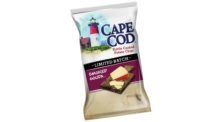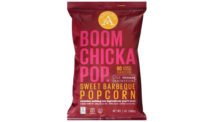American takeout standbys like pizza and Chinese food should watch their backs, because Mexican cuisine is close behind, says the “Global Palates 2015” report from the National Restaurant Association. Of the 1,000 people surveyed by the association, half of them reported eating Mexican food at least once a month (trailing just 11 percentage points behind Italian food, which was the most popular).
Overview | Chips | Puffed/Extruded Snacks | Popcorn | Snack Mixes & Nuts | Tortilla Chips | Pretzels | Frozen Snacks | Crackers
So it should come as no surprise that sales of a Mexican culinary staple like tortilla chips continue to do well—in both foodservice and retail.
But while traditional tortilla chips continue to dominate retail sales, a strong contingency of next-generation, better-for-you tortilla chips are poised to challenge for more market share.
Market data
According to data from IRI, Chicago, dollar sales of tortilla/tostada chips grew 4.43 percent in the 52 weeks leading up to April 17, 2016, amassing $4.9 billion in sales. Grupo Bimbo grew 29.15 percent in dollar sales over the course of the year to reach $208.5 million in sales, largely spurred by its Barcel Takis brand—a rolled tortilla chip—which was up 31.13 percent to $183.8 million. The popular Fuego variety combines spicy chili and lime flavors.
Restaurant-style tortilla chips continue to build a following, as evidenced by the 10.20 percent dollar sales growth from the On the Border brand, owned by Truco Enterprises, with branding aligned with the casual-dining chain of the same name. Sales for the past year hit $155.9 million.
As is the case elsewhere in salty snacks, private label brands perform well in the tortilla chips segment. Over the past year, private brands grew by 18.20 percent in dollar sales to $255.6 million to sit in the No. 2 slot behind category leader PepsiCo/Frito-Lay.
Perennial favorites like Doritos and Tostitos had a good year, with the former growing 6.72 percent in dollar sales to reach $2.0 billion, and the latter picking up 2.99 percent growth to reach $646.7 million. Tostitos Scoops followed in the No. 3 brand slot, growing by 3.40 percent to reach $467.6 million.
The Tostitos Simply Tortilla products also fared well, up 11.45 percent in dollar sales to $25.2 million, indicating a willing market for organic, clean-label salty snacks.
The natural-oriented brand Garden of Eatin’ brand from The Hain Celestial Group saw modest growth for the year, with its Blue Chips up by 2.79 percent in dollar sales to $31.0 million and its regular tortilla chips up 1.18 percent to $25.4 million.
Looking back
“Tortilla chips are often the snack of choice, because they are delicious on their own,” says Genelle Chetcuti, senior director of marketing, RW Garcia, San Jose, CA.
This statement rings true for the segment leader Doritos—but also for many of the next generation tortilla chip products that incorporate a wide range of seeds, legumes, vegetables and even fruit.
“Tortilla chips are a vibrant category with a diverse subset of product dimensions,” says Andrea Brule, vice president and general manager, Sugar Foods Corporation, New York, manufacturers of The Better Chip products. “Tortilla chips can be as straightforward as fried corn flour, or as complex as you like with seasonings, different flours and inclusions. Because of this, we see a wide range of product attributes, price points and positioning in the market.”
Recent additions to The Better Chip line include Radish Chia (made with radish, chia seeds and garlic) and Salsa Verde (made with tomatillo, cilantro, onion and serrano chiles). “It’s a real unique flavor experience with whole ingredients and no flavor dust or topical seasonings,” says Brule. “We are getting a lot of positive reactions to Radish Chia, as a surprising flavor profile that people have never tried before. We love that—the element of surprise.” The products are certified gluten-free and Non-GMO Project Verified.
Without a doubt, the biggest trend among tortilla chips is flavor. “We’re seeing more diverse, on-trend, simple inclusion ingredients to deliver innovative tortilla chip flavor profiles, capturing consumer demand for exotic combinations,” says Chetcuti. “Black beans, chickpeas, root vegetables, and quinoa and other ancient grains are just some of the clean ingredients we include in tortilla chips to enhance the nutritional and flavor profiles.”
RW Garcia’s three MixtBag varieties—Red and Yellow Corn, Yellow and Blue Corn, and Veggie—are Non-GMO Project Verified and certified gluten-free. On the packaging side, they’re also made to persuade purchase by convenience-minded millennial shoppers by featuring a resealable closure.
Frito-Lay’s Doritos brand is also experimenting with mixed products—and a bit of novelty. Doritos Mix products include Doritos, rolled tortilla chips (a la Dinamita or Takis) and two third-generation extruded pieces. Varieties include Taco Explosion and Cheese Explosion.
At Minneapolis-based Way Better Snacks, flavor has taken center stage, evidenced by Sweet Chili and Sriracha varieties, as well as even more-unique, seasonal options. In 2015, its limited-edition Pumpkin Cranberry chip was joined by Ginger Snap, a new seasonal flavor. “These delicious holiday chips are made with real fruit and ginger pieces baked right in for a delicate sweetness, perfectly balanced with a hint of pure sea salt,” says Emily Harris-Greene, vice president of marketing for the company. This year, the company added Ginger Sweet Potato to its range, which is a twist on its best-selling Sweet Potato variety.
With such flavor-forward tortilla chips, some folks might just forego the dip. “These inventive flavors provide satisfying snacking options and extend usage occasions beyond the traditional chip and salsa pairings,” Harris-Greene says.
Newly launched Organic Trail Chips from Pure Foods offer flavor profiles previously not seen in the salty snacks category. Products are based on various seeds and grains—including ancient grains—with the Wildberry Medley chips then adding in cranberries and blueberries, while Tropical Medley features bananas, pineapples and coconuts. Additional flavors are also in the works.
The omnipresent better-for-you trend is also hitting tortilla chips, as ancient grains and whole grains sprout up in offerings across the market. “Consumers want to eat foods that nourish them and provide the nutritional benefits they need without sacrificing great taste,” says Harris-Greene. “Crafting snacks with sprouted ancient grains is a great way to offer those benefits to consumers.”
Looking ahead
Tortilla chip growth is rippling across the production line, says Sergio Caballero, regional sales manager FoodTools Consolidated, Inc., Santa Barbara, CA, who has seen an increase in customer demands for restaurant-style tortilla chips and the machines needed to produce them.
That said, Caballero has a word of advice for those operating in this market: “One thing that I have been learning with the tortilla chip industry is that some of these chip manufacturers have been using machines that were made many years ago by their grandparents—who started the company—and haven’t replaced them since. It’s the old saying, ‘Why fix what’s not broken?’” But with safety and cleanliness standards having changed much in that time, as well as flavor and ingredient trends, Caballero has prioritized working with tortilla chip brands to be sure their products are made on machines that can deliver peak quality—and safety.
With so many options on the market, tomorrow’s successful brands will need to stand out—but how? For Chetcuti, the answer lies in pushing the envelope with bold flavors, while also tapping into millennials’ desire for fun, convenient and dip-friendly tortilla chip formats. “Understanding what makes consumers choose tortilla chips over other snack options represents the greatest opportunity toward product diversification,” she says. “Regional and local taste and flavor preferences can vary greatly, and catering to these niche markets will help smaller brands stand out.”
Innovation will continue, says Brule. “Tortilla chips are an easy canvas to paint on from an innovation standpoint.”
Overview | Chips | Puffed/Extruded Snacks | Popcorn | Snack Mixes & Nuts | Tortilla Chips | Pretzels | Frozen Snacks | Crackers










